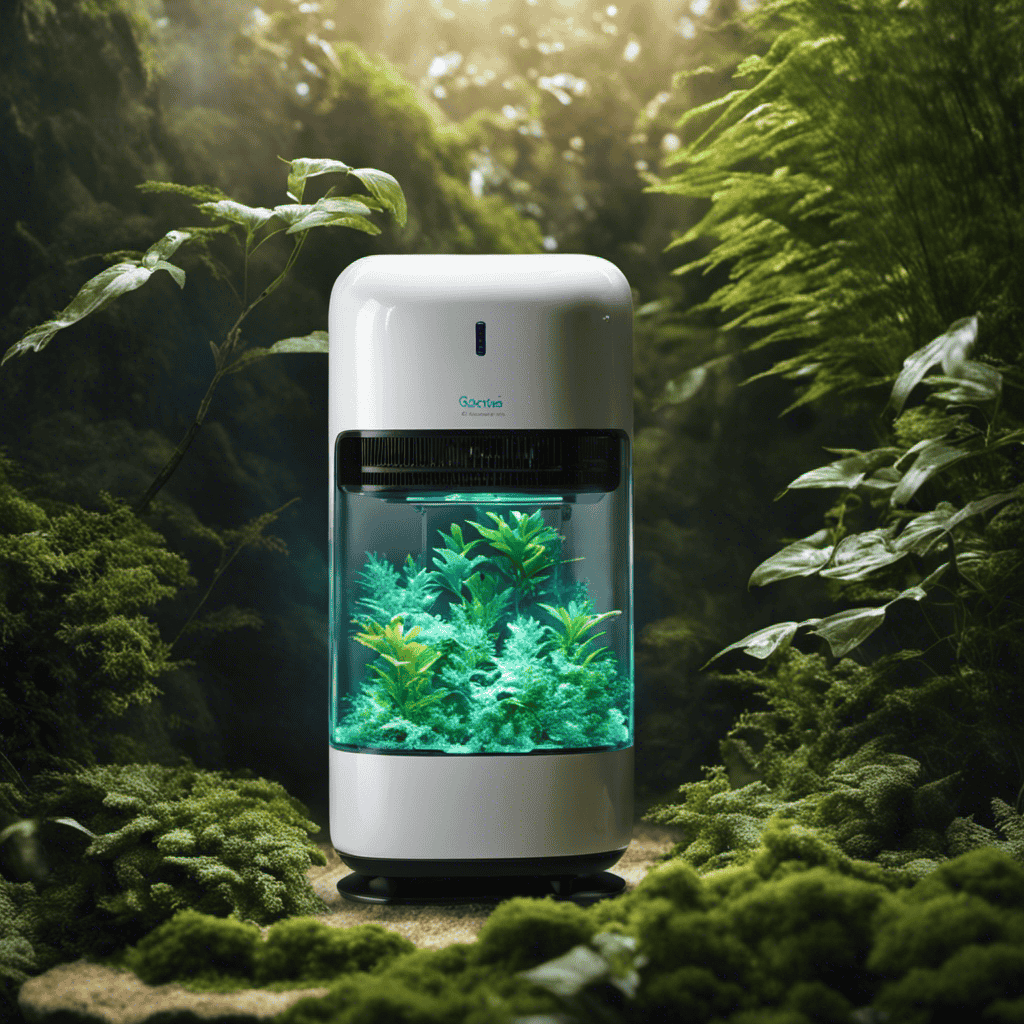I have always been curious about the intriguing technology behind air purifiers as someone who values clean and fresh air. How do these devices work to remove impurities and improve air quality?
In this article, we delve into the intricate workings of air purifiers, exploring the technology, components, and processes that contribute to their effectiveness.
Prepare to be amazed as we unravel the secrets of how air purifiers filter and circulate air, ultimately enhancing the quality of the air we breathe.
Key Takeaways
- Air purifiers use filters to capture and remove particles from the air.
- HEPA filters trap smaller particles such as pollen and smoke.
- Activated carbon filters help eliminate odors and volatile organic compounds.
- Understanding the purification mechanism helps in appreciating the effectiveness of activated carbon filtration.
The Basics of Air Purifiers
Air purifiers use filters to capture and remove particles from the air, improving indoor air quality. Understanding filtration technology is essential to grasp how air purifiers work.
These devices typically employ a combination of filters, including pre-filters, HEPA filters, and activated carbon filters. Pre-filters catch larger particles like dust and pet dander, while HEPA filters trap smaller particles such as pollen and smoke. Activated carbon filters help eliminate odors and volatile organic compounds.
By removing these contaminants, air purifiers can provide numerous benefits. They can reduce allergies and asthma symptoms, remove harmful pollutants, and create a cleaner and healthier living environment.
Understanding the filtration process is a crucial step in comprehending air purification technology and its effectiveness in improving indoor air quality.
Understanding Air Purification Technology
To understand how an air purifier works, you’ll want to know how it filters and cleans the air in your home. Here are four key points to help you understand air purification techniques and the benefits of using air purifiers:
-
Filtration: Air purifiers use filters to trap pollutants and particles in the air. HEPA filters are particularly effective at capturing small particles like dust, pollen, and pet dander.
-
Activated Carbon: Many air purifiers also utilize activated carbon filters to remove odors, chemicals, and gases from the air. The carbon absorbs these substances, leaving the air fresher and cleaner.
-
UV-C Light: Some air purifiers incorporate UV-C light technology to kill bacteria, viruses, and other germs in the air. This helps to reduce the spread of illnesses and improve overall indoor air quality.
-
Ionization: Certain air purifiers use ionizers to release negatively charged ions into the air. These ions attach to positively charged particles, causing them to become heavy and drop out of the air, effectively removing them.
Understanding these air purification techniques and the benefits they provide can help you make an informed decision when choosing an air purifier for your home.
Key Components of an Air Purifier
When it comes to air purification, understanding the air filtration process is crucial. The purification mechanism explained in detail can help us grasp the intricacies of how an air purifier works to clean the air.
Additionally, knowing the essential components of a purifier is essential in order to make an informed choice when selecting the right device for our needs.
Air Filtration Process
The main filter in an air purifier is called a HEPA filter. It traps small particles like dust, pollen, and pet dander.
Here is a breakdown of the air filtration process and the benefits of clean air:
-
Pre-filtration: The air first passes through a pre-filter that captures larger particles such as hair and lint. This helps prolong the life of the HEPA filter.
-
Activated carbon filtration: Next, the air moves through an activated carbon filter that removes odors, gases, and volatile organic compounds (VOCs). This process helps eliminate unpleasant smells and harmful chemicals.
-
HEPA filtration: The most critical step is the HEPA filter. It effectively captures 99.97% of particles as small as 0.3 microns, including allergens, bacteria, and viruses. This ensures cleaner air for a healthier environment.
-
Ionization or UV-C light: Some air purifiers also incorporate ionization or UV-C light to further enhance air purification by neutralizing or killing airborne pathogens.
Purification Mechanism Explained
Activated carbon filtration helps eliminate unpleasant smells and harmful chemicals by removing odors, gases, and volatile organic compounds (VOCs). The mechanism behind this process is quite fascinating. As air passes through the activated carbon filter, the carbon material traps and absorbs the pollutants present in the air. This is achieved through a process called adsorption, where the pollutants adhere to the surface of the carbon particles. The activated carbon has a large surface area and a porous structure, which enhances its ability to capture a wide range of contaminants. The table below provides a visual representation of the air purification process using activated carbon filtration:
| Step | Description |
|---|---|
| Step 1 | Air containing pollutants enters the purifier |
| Step 2 | The air passes through the activated carbon filter |
| Step 3 | Pollutants such as odors, gases, and VOCs are trapped and absorbed by the carbon |
| Step 4 | Clean and purified air is released back into the environment |
Essential Purifier Components
One important component of an essential purifier is an activated carbon filter. This filter plays a crucial role in removing harmful particles and odors from the air.
Here are four key benefits of using an air purifier with an activated carbon filter:
-
Improved Indoor Air Quality: The activated carbon filter effectively traps and removes pollutants such as dust, pollen, pet dander, and smoke, resulting in cleaner and fresher air for you to breathe.
-
Allergen Reduction: With its ability to capture allergens, an activated carbon filter can help alleviate symptoms for allergy sufferers, providing relief from sneezing, coughing, and congestion.
-
Odor Elimination: The filter absorbs and neutralizes unpleasant smells from cooking, pets, and other sources, leaving your home smelling clean and fresh.
-
Long-lasting Filter Life: Proper air purifier maintenance, such as regular filter replacement, ensures optimal performance and extends the lifespan of the activated carbon filter, saving you money in the long run.
How Does an Air Purifier Filter Air
You might be wondering how an air purifier actually filters the air. Well, let me explain it to you in a scientific and detailed manner.
Air purifiers are equipped with a series of filters that work together to remove pollutants and impurities from the air. The first line of defense is usually a pre-filter, which captures larger particles like dust and pet hair.
Then, the air passes through a HEPA filter, which effectively traps tiny particles such as pollen, mold spores, and bacteria. Some air purifiers also feature an activated carbon filter, which helps to eliminate odors and harmful chemicals.
Additionally, certain models use ultraviolet (UV) light or photocatalytic oxidation to neutralize germs and viruses.
By removing these contaminants, air purifiers can greatly improve indoor air quality, reducing allergies, asthma symptoms, and promoting overall respiratory health.
Regular air purifier maintenance, such as cleaning or replacing filters, is crucial to ensure optimal performance and reap the full benefits of air purifiers.
The Role of Fans in Air Purifiers
In this discussion, I will be exploring the role of fans in air purifiers. Specifically, I will focus on fan circulation and purification, as well as the importance of air movement.
Fans play a crucial role in air purifiers. They create airflow that helps to circulate the air in a room and push it through the purification process. This circulation is essential for ensuring that all the air in the room is filtered and purified effectively.
Additionally, the movement of air caused by the fans helps to prevent stagnant air from settling. This reduces the chances of contaminants and allergens from lingering in the environment.
Overall, fans are an integral component of air purifiers. They facilitate the circulation and purification of air, as well as promote air movement to maintain a clean and healthy environment.
Fan Circulation and Purification
The air purifier uses a fan to circulate and purify the air. The fan operation plays a crucial role in the overall performance of the device. Here are four key points on how the fan helps in air purification:
-
Air intake: The fan pulls air from the surrounding environment into the purifier, allowing it to be processed and cleaned.
-
Filtration: As the air is drawn in, it passes through various filters that capture dust, pollen, pet dander, and other pollutants, helping to improve indoor air quality.
-
Airflow distribution: The fan ensures that the purified air is evenly distributed throughout the room, eliminating stagnant areas and promoting a healthier living environment.
-
Odor elimination: By continuously circulating the air, the fan helps to remove unpleasant odors, such as cooking smells or pet odors, leaving the space smelling fresh and clean.
With these air purification techniques in mind, it becomes evident that the fan is a vital component in ensuring effective air cleaning. Now, let’s explore the importance of air movement in the subsequent section.
Importance of Air Movement
Now that we understand the role of the fan in air purification, it’s important to recognize the significance of air movement in maintaining a healthy indoor environment.
Airflow patterns play a crucial role in the distribution of clean air throughout a space. Proper air circulation helps to remove pollutants, allergens, and other contaminants from the air, creating a safer and more comfortable environment.
The benefits of air circulation are numerous. Firstly, it helps to prevent the buildup of stagnant air, which can lead to the growth of mold and mildew. Additionally, it helps to regulate temperature and humidity levels, reducing the risk of moisture-related issues. Lastly, air circulation aids in the dispersion of odors, ensuring a fresh and clean atmosphere.
Overall, incorporating effective airflow patterns into indoor spaces is essential for promoting and maintaining optimal air quality.
Air Circulation and the Air Purifier
To understand how an air purifier pulls air, imagine yourself standing next to the device and feeling the gentle breeze it creates. The airflow direction is crucial for effective air purification. Here are four key points to consider:
-
Intake: The purifier draws in air from its surroundings through strategically placed vents or grilles.
-
Filtration: Inside the unit, the air encounters multiple filters designed to capture particles such as dust, pollen, and pet dander.
-
Air Exchange Rate: The purifier continuously circulates the air, pulling in new air while expelling purified air back into the room.
-
Outflow: Once the air has passed through the filters, it is released back into the room, creating a cleaner and healthier environment.
Understanding the airflow direction and air exchange rate is crucial for optimizing the performance of an air purifier.
Now, let’s delve into the mechanisms of air intake in air purifiers.
Mechanisms of Air Intake in Air Purifiers
Imagine yourself standing next to the device and feeling the gentle breeze it creates, allowing fresh air to be drawn in through strategically placed vents or grilles.
One of the key mechanisms that enable an air purifier to pull in air is airflow control. Through the use of fans and adjustable vents, the air purifier can regulate the speed and direction of the airflow, ensuring that air is efficiently drawn into the device.
This airflow control is crucial for maintaining optimal filter efficiency. By controlling the speed and direction of the airflow, the air purifier can effectively guide the air through the filters, allowing them to capture and remove contaminants.
The filter efficiency of an air purifier is directly related to the airflow control, as a well-controlled airflow ensures that all the air passing through the filters is thoroughly cleaned.
Exploring the Air Purification Process
By effectively controlling the airflow, an air purifier ensures that contaminants are efficiently captured and removed by the filters. Here’s a detailed breakdown of the air purification process:
-
Fan Efficiency: The fan in an air purifier plays a crucial role in pulling air into the unit. It is designed to create a strong and consistent airflow, optimizing the filtration process. High fan efficiency ensures that a large volume of air is circulated, increasing the effectiveness of the purification process.
-
Pre-Filtration: As the air enters the purifier, it passes through a pre-filter. This filter is designed to capture larger particles such as dust, pet hair, and lint. By removing these particles, the pre-filter helps to extend the lifespan of the main filters and improve overall air quality.
-
Main Filtration: The air then moves through the main filters, which typically include a HEPA filter and an activated carbon filter. The HEPA filter removes microscopic particles like pollen, mold spores, and bacteria, while the activated carbon filter absorbs odors, gases, and volatile organic compounds (VOCs).
-
Clean Air Delivery: Once the air has been filtered, it is released back into the room, providing clean and purified air. This process helps to reduce allergens, pollutants, and odors, promoting a healthier indoor environment.
The benefits of air purification are numerous, including improved respiratory health, reduced allergies, and a cleaner living space. By effectively controlling airflow and utilizing efficient fans, air purifiers can enhance the quality of the air we breathe.
Enhancing Indoor Air Quality With Air Purifiers
Improving indoor air quality is essential for a healthier living environment, and air purifiers play a significant role in achieving this goal. Indoor pollution can be a major concern, with pollutants like dust, pet dander, and volatile organic compounds (VOCs) present in our homes.
Air purifiers work by pulling in air through an intake vent, which then passes through a series of filters. These filters trap and remove particles and pollutants, ensuring cleaner air is released back into the room.
However, to maintain the effectiveness of an air purifier, regular maintenance is required. This includes cleaning or replacing filters, emptying collection trays, and ensuring proper airflow. Neglecting air purifier maintenance can lead to a decrease in performance and efficiency, compromising the indoor air quality.
Therefore, it is crucial to follow the manufacturer’s guidelines for maintenance to maximize the benefits of an air purifier in enhancing indoor air quality.
Conclusion
In conclusion, understanding how an air purifier pulls in air is crucial in improving indoor air quality.
The air purification process involves key components such as filters, fans, and air circulation mechanisms.
By effectively filtering out pollutants and allergens, air purifiers can significantly enhance the air we breathe.
Interestingly, studies have shown that using an air purifier can reduce airborne particles by up to 99.97%, providing a cleaner and healthier environment.
Investing in an air purifier is a wise decision for anyone seeking to improve their indoor air quality.










